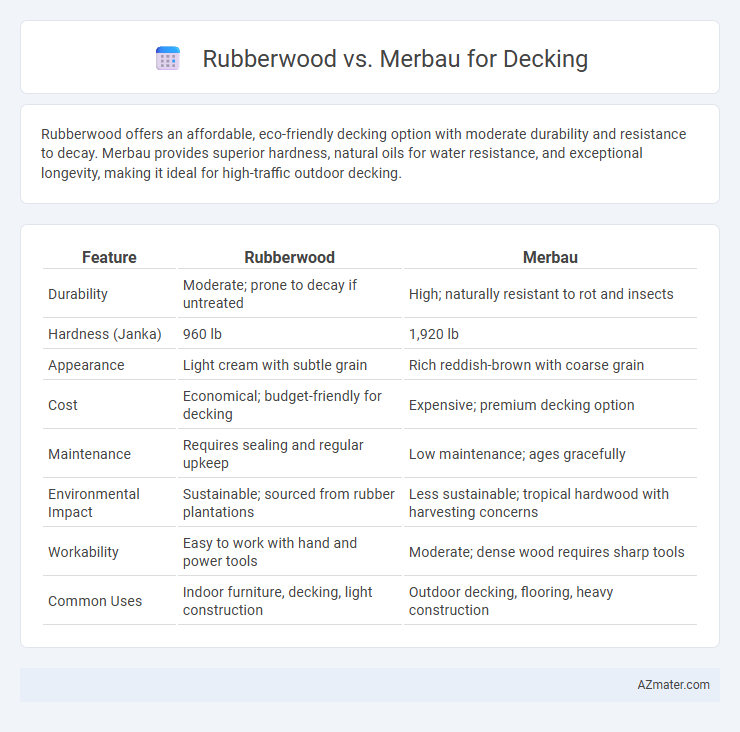Rubberwood offers an affordable, eco-friendly decking option with moderate durability and resistance to decay. Merbau provides superior hardness, natural oils for water resistance, and exceptional longevity, making it ideal for high-traffic outdoor decking.
Table of Comparison
| Feature | Rubberwood | Merbau |
|---|---|---|
| Durability | Moderate; prone to decay if untreated | High; naturally resistant to rot and insects |
| Hardness (Janka) | 960 lb | 1,920 lb |
| Appearance | Light cream with subtle grain | Rich reddish-brown with coarse grain |
| Cost | Economical; budget-friendly for decking | Expensive; premium decking option |
| Maintenance | Requires sealing and regular upkeep | Low maintenance; ages gracefully |
| Environmental Impact | Sustainable; sourced from rubber plantations | Less sustainable; tropical hardwood with harvesting concerns |
| Workability | Easy to work with hand and power tools | Moderate; dense wood requires sharp tools |
| Common Uses | Indoor furniture, decking, light construction | Outdoor decking, flooring, heavy construction |
Introduction to Rubberwood and Merbau Decking
Rubberwood decking offers a sustainable and eco-friendly choice derived from the Hevea brasiliensis tree, known for its durability and light color that complements modern outdoor designs. Merbau decking, sourced from the Intsia bijuga tree, is prized for its rich, reddish-brown hue, exceptional hardness, and natural resistance to termites and decay, making it ideal for high-traffic outdoor spaces. Both woods provide strong structural integrity but differ significantly in aesthetics, maintenance, and environmental impact, guiding homeowners in selecting the most suitable material for their decking needs.
Origin and Sustainability of Rubberwood vs Merbau
Rubberwood, harvested primarily from plantations in Southeast Asia such as Malaysia and Thailand, is a byproduct of the latex industry, making it a highly sustainable decking option due to its use of mature trees no longer producing latex. Merbau, native to Southeast Asia's tropical rainforests, is a dense hardwood often sourced from natural forests, raising concerns about deforestation and environmental impact when not sustainably managed. Choosing rubberwood supports sustainable forestry practices by utilizing plantation-grown timber, whereas selecting certified Merbau ensures responsible harvesting from managed forests, impacting the ecological footprint of decking projects.
Appearance and Color Variations
Rubberwood features a light beige to pale brown color with subtle grain patterns, making it ideal for contemporary decking designs that require a uniform, smooth appearance. Merbau offers a rich reddish-brown hue with deep, dark streaks and a natural luster that enhances outdoor spaces with a warm, tropical aesthetic. Color variations in Merbau are pronounced and dynamic, while Rubberwood maintains a more consistent tone, affecting long-term appeal and maintenance for decking projects.
Durability and Lifespan Comparison
Rubberwood offers moderate durability with a natural resistance to decay but requires proper treatment to withstand outdoor conditions, typically lasting around 10-15 years when used for decking. Merbau demonstrates exceptional durability and high resistance to termites, fungi, and harsh weather, often extending the lifespan of decks beyond 25 years. The significant density and natural oils in Merbau contribute to its superior longevity compared to the more affordable yet less resistant Rubberwood.
Resistance to Weather and Insects
Rubberwood offers moderate resistance to weather but requires proper treatment to prevent moisture absorption and insect damage, making it less durable in harsh outdoor conditions. Merbau is highly resistant to weathering and insects due to its dense, oily grain, which naturally repels termites and fungal attacks, ensuring long-lasting decking performance. In tropical climates, Merbau outperforms Rubberwood by maintaining structural integrity and aesthetic appeal with minimal maintenance.
Maintenance Requirements
Rubberwood decking demands minimal maintenance due to its naturally dense grain, but requires periodic sealing to prevent moisture absorption and prolong its lifespan. Merbau decking, known for its high oil content and hardness, offers superior resistance to rot and insect attacks, reducing the need for frequent treatments, though occasional oiling maintains its rich color and surface durability. Both materials benefit from regular cleaning to remove debris and prevent mold growth, yet Merbau generally endures harsh weather conditions with less upkeep compared to Rubberwood.
Cost Factors and Affordability
Rubberwood offers a cost-effective option for decking due to its widespread availability and rapid growth cycle, making it significantly more affordable than Merbau. Merbau, a dense hardwood prized for its durability and rich color, commands a higher price driven by limited supply and longer maturation periods. When considering decking affordability, Rubberwood excels in budget-conscious projects, whereas Merbau's premium cost reflects its superior longevity and resistance to outdoor elements.
Installation Process and Workability
Rubberwood offers ease of installation due to its lightweight nature and uniform grain, allowing for smooth cutting, nailing, and screwing, which reduces labor time and effort during decking projects. In contrast, Merbau's dense and hard texture demands specialized tools and pre-drilling to prevent splitting, increasing installation complexity but providing superior durability once installed. Both woods require proper treatment to resist moisture and insects, but Rubberwood's workability makes it a preferred choice for DIY decking installation while Merbau suits professional applications requiring long-term resilience.
Environmental Impact and Certifications
Rubberwood decking is considered eco-friendly due to its origin from plantation timber sourced as a byproduct of the rubber industry, reducing deforestation pressure, and often carries FSC or PEFC certifications ensuring sustainable management. Merbau, a tropical hardwood known for its durability, faces environmental concerns from illegal logging, but certified versions under FSC promote responsible forestry practices. Choosing FSC-certified rubberwood or merbau decking supports sustainable forestry, minimizes carbon footprint, and helps conserve biodiversity.
Final Verdict: Choosing Between Rubberwood and Merbau Decking
Rubberwood offers an eco-friendly, affordable option with moderate durability and easy maintenance, making it suitable for low-traffic or covered decks. Merbau stands out for its superior hardness, natural resistance to decay and insects, and rich reddish-brown color, ideal for high-traffic outdoor decking with long-term durability. Selecting between Rubberwood and Merbau depends on budget constraints, desired longevity, and exposure to environmental stress, with Merbau preferred for premium, enduring outdoor decking solutions.

Infographic: Rubberwood vs Merbau for Decking
 azmater.com
azmater.com